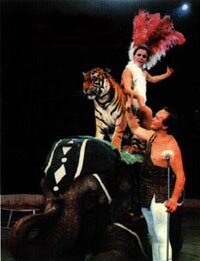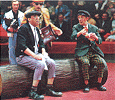The history of the St.-Petersburg circus on Fontanka
Circus performances were a success in St Petersburg even in the XVIII century.
They took place at the squares during the public merry-making and at the riding schools. In the XIX century, special circus buildings began to be built. However, they were made of wood and were not convenient. The first stationary circus of this kind, Turniera's Circus, was built in 1827 about the same place the circus stands now.
120 years ago, on 26th December 1877 there was the opening of the Circus-on-Fontanka, the first Russian building of stone specified for the circus, the architect being V. A. Kenel.

The idea of the stone circus occurred to the Italian circus actor, rider and trainer Gaetano Ciniselli, being the head of a large circus family first arrived in St.Petersburg on tour in 1847.

The building of the new circus was considered one of the most beautiful circus buildings in Europe.

It impressed the contemporaries with perfect proportions and elegant decorations: the muses' figures in the arched window openings, the allegoric sculpture group in the centre of the cornice with theatre masks, the pediments with high relieves of horse heads. The interior of the circus was also well dressed: the hall was abundantly decorated with gilding, crimson velvet, mirrors, cut-glass chandeliers, and the plafond depicted some typical scenes of equestrian vaulting.
Ciniselli's Circus, called so before the Revolution, played a remarkable role in the development of circus art in Russia. It represented the best circus actors from all over the world. Among them were the famous clowns Billy Hyden and Jacomino, the grotesque rider Mademoiselle Adel and the air gymnast Miss Zinobia, the rider James Fillies, being the idol of the society, the Russian clowns and trainers the Durov brothers, Anatoly and Vladimir.

The circus represented splendidly staged pantomimes and water fairy-scenes "Cinderella," "Robert and Bertram," "Fiamette the Queen of Robbers", "Nibekmgen" etc., championships of classic wrestling popular at those times. Aristocracy considered going to Ciniselli's Circus as fashionable as going to Mikhailovsky Theatre. 'According to the order prescribed by the tradition, on Saturdays, the majority of officers went to Ciniselli's Circus, housing the whole of St.Petersburg merry-making,' recollected A. A. Ignatyev in his book called "Fifty Years at Duty." The admirers of that circus were A. I. Kuprin and D. V. Grigorovich. A. A. Bloc and F. I. Shalyapin.
In 1919, Ciniselli's Circus was transferred to the State, and in 1924, W.J. Truzzi, being a talented producer, organiser, brilliant actor and horse trainer, was appointed the first Director of Leningrad Circus.

The 20s and 30s were the years of making the Soviet circus. Though the playbills still contained some foreign names, Soviet actors gained the leading position at the circus arena.
At that time Leningrad Circus represented the popular satire clown Vitaly Lazarenko, the musical clowns the Tanti Brothers, the clowns Franz and Friez, the gymnasts A. And M.Shiray, the ropewalkers Svirins, the traner A.N.Aleksandrov-Fedotov etc. It was at Leningrad Circus that the clown Pavel Alekseyevich replaced the traditional mask of the "red" with an everyday comic image, and the clown M.N.Rumyantsev became the famous Karandash.
That was the time to create such large-scale pantomimes as "Makhnovshchina" (1930), "Black Pirate" (1934) with horses, fire and waterfall, fountains and fireworks being the apotheosis. The water attraction "People of the Marine Ground" (1935) demonstrated the technical achievements of the divers working at the EPRON. The circus play "Taiga on Fire" (1938) touched upon the Civil War at the Far Bast, etc. The 30s were the period of fruitful work fur the circus producers and figures, among them being Ye. M. Kuznetsov, Ye. N. Gershuni, Yu. S. Yursky, B. A. Shakhet.
In 1939, the great creative merits of Leningrad Circus were rewarded with the Order of Red Banner of Labour.
The Great Patriotic War, and the blockade of Leningrad interrupted the work of the circus. It was re-opened on 28th November 1944.
The post war period of Leningrad Circus's creative activity was connected with the Honoured Art Worker of the RSFSR G. S. Venetsianov, the Art Director of Leningrad Circus from 1946 to 1965.
Those were the years Leningrad Circus showed the pantomime "Celebration on Water" (1952); the colourful performance "Carnival on Ice" (1952); being the first attempt to create an ice arena; the topic water pantomime "Shot in the Cave" (1955); as well as topic performances "Women as Masters of the Circus" (1951); "Golden Fall" (1953); "Animal Circus" (1954) etc. At the same time, the Leningrad Circus opened the studio for musical clownery and equestrian acrobatics, its several graduates having still been working at the arena.
The creative activity of many famous actors is connected with the Circus-on-Fontanka. G. S. Venetsianov, a brilliant expert of the equestrian genre, created his circus turns together with the magnificent trainer B.P. Manjelli. It was here that E.T. Kio worked on renewal of his illusion attraction. Leningrad was the place to originate the creative life of Valentine Filatov's "Bear Circus". G.S. Venetsianov paid much attention to the clown genre. It was for eleven seasons running that the remarkable clown Boris Vyatkin was working. At the same time, the actors D. Demash and G. Mosel represented the genre of buffoon clownery, and the clown Konstantin Musin brightly realised his original talent.
The best creative traditions go on living at Leningrad (St Petersburg) Circus in the latest decades as well.
The best creative traditions go on living at Leningrad (St Petersburg) Circus in the latest decades as well. Leningrad Circus's arena was repeatedly adorned by the famous actor dynasties of the Durovs, Filatovs, Zapashnys, Olkhovikovs, Volzhanskys, Kyos, Aleksandrovs-Serzhs, Kochs, Kantemirovs.

It was here that the remarkable clowns Yury Nikiilin and Mikhail Shuydin, Oleg Popov, Leonid Engibarov, Evgeny Maikhrovsky, Gennady Makovsky, Anatoly Marchevsky, Yury Kuklachev; the famous trainers Irina Tugramova, Margarita Nazarova, Ludmila and Vladimir Shevchenkos, Boris Biryukov, Nikolay Pavlenko, Irina and Ivan Yarovoys, Ludmila and Vladimir Deryabkins; the Djigits ensemble under the leadership of Tamerlan Nugzarov, the juggler Sergey Ignatov, the illusionists Lubov and Anatoly Sudarchikovs, the air flight under the leadership of Vladimir Garamov and a Sot of other masters of the arena.
  
The Circus-on-Fontanka cooperated and is still cooperating with the composers B. Solovyov-Sedoy, 0. Khromushin, A. Kalvarsky, G. Firtich, Ya. Dubravin; poets S. Orlov, V. Toropygin, Ì. Dudin, V. Suslov, O. Chuprov; the script writers A. Minchkovsky, A. Barten, I. Tunchin, K. Ryzhov, M. Fradkin, K. Pogorelsky, I. Vinogradsky; the artists V. Ryndin, T. Bruny, S. Mandel, V. Galba, O.Orevin etc.
Among the directors who contributed largely into the development of the circus art were V.A. Tsvctkov (1951-1974), I.N. Kirnos (1974-1981), V.A. Kuznetsov (1981-1987). Since 1987, St Petersburg Circus's Director is G.P. Gaponov.
Since 1965, the Head Producer, the Honoured Art Worker of Russia Aleksey Sonin carries out the art guidance of the Circus.
The Head Conductor, the Honoured Art Worker of Russia Semyon Chebushev supervises the musical aspect of the Circus. From 1971 to 1994, the Head Artist of the Circus was Rimma Yunosheva, whose bright and original paintings adorned any show. Since 1995, me Producing Artist of the Circus is Nika Velegzhaninova. The spectacular aspect is since 1984 supervised by Boris Vlasov. Ruslan Spikhin, the former actor heading the circus turn "Acrobats on Battuta", heads the uniform workshop. The duties of the Inspecting Producers of the Arena were for a long time performed by R.M. Balanovsky, V.V. Miroslavsky, M.L. Carpov, being also famous circus actors in their past.
Since August 1928, Leningrad Circus s building houses also the Circus and Variety Art Museum (now called the Circus Art Museum) initiated by the teacher of the Theatre School V.Ya. Andreyev. It was the first and the only establishment of its kind in the world, and up to now the Museum remains a unique collection concentrating the materials and documents reflecting the history of both domestic and foreign circuses.
The Museum's funds attract the attention of cinema and TV producers, artists, writers, actors, art critics, students and ordinary amateurs of the circus. The Museum holds the excursions for adults and children. It leads international correspondence and exchanges materials with foreign circus workers and collectors of different countries.
In 1994, St. Petersburg Circus together with the Academy for Theatre Art organised recruitment of the students to be taught the profession of a circus and variety actor and producer, the head of the course being the Assistant Professor A. A. Sonin.
St.Petersburg Circus is one of the leading spectacular circuses of the country. It is here that the pantomimes, topic performances and performances for children are created. Among the most significant productions one should mention the three part review "Parade Allais" dedicated to the 100-jubilee of Leningrad Circus (1977), the date being the occasion to reward the Circus with the Order of Peoples' Friendship; fairy pantomime "Ruslan and Ludmila" (1979); the circus play "The Most Joyful Day" after A.P. Chekhov's story "Kashtanka" (1985). Among the latest productions noteworthy are "Masters 13" (1993). "Guarantee of Success''' (1994), "Circus Jockey and Queen of the Arena"(1995), "Today Here, Tomorrow There" (1997), plays for children "Do Not Touch Le Monti" (1994), "We Do Know These Tales" (1996), "Take the Bull by the Horns", "House without Comers" (1997) etc.
March 17, 1999 has opened site of a circus in Internet.
You can familiarize with materials on a history of a circus in a museum of a circus.
|

 Complete playbill of all St. Petersburg,Russia theatres, shows, concerts, etc. !
Complete playbill of all St. Petersburg,Russia theatres, shows, concerts, etc. !
 World-known music festival "The Stars of the White Nights".
World-known music festival "The Stars of the White Nights".







